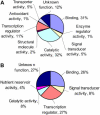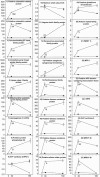Necrosis- and ethylene-inducing peptide from Fusarium oxysporum induces a complex cascade of transcripts associated with signal transduction and cell death in Arabidopsis
- PMID: 16698904
- PMCID: PMC1489885
- DOI: 10.1104/pp.106.076869
Necrosis- and ethylene-inducing peptide from Fusarium oxysporum induces a complex cascade of transcripts associated with signal transduction and cell death in Arabidopsis
Abstract
Treatment of Arabidopsis (Arabidopsis thaliana) with a necrosis- and ethylene-inducing peptide (Nep1) from Fusarium oxysporum inhibited both root and cotyledon growth and triggered cell death, thereby generating necrotic spots. Nep1-like proteins are produced by divergent microbes, many of which are plant pathogens. Nep1 in the plant was localized to the cell wall and cytosol based on immunolocalization results. The ratio of chlorophyll a fluorescence (F685 nm/F730 nm) significantly decreased after 75-min treatment with Nep1 in comparison to the control. This suggested that a short-term compensation of photosynthesis occurred in response to localized damage to cells. The concentrations of most water-soluble metabolites analyzed were reduced in Arabidopsis seedlings after 6 h of Nep1 treatment, indicating that the integrity of cellular membranes had failed. Microarray results showed that short-term treatment with Nep1 altered expression of numerous genes encoding proteins putatively localized to organelles, especially the chloroplast and mitochondria. Short-term treatment with Nep1 induced multiple classes of genes involved in reactive oxygen species production, signal transduction, ethylene biosynthesis, membrane modification, apoptosis, and stress. Quantitative PCR was used to confirm the induction of genes localized in the chloroplast, mitochondria, and plasma membrane, and genes responsive to calcium/calmodulin complexes, ethylene, jasmonate, ethylene biosynthesis, WRKY, and cell death. The majority of Nep1-induced genes has been associated with general stress responses but has not been critically linked to resistance to plant disease. These results are consistent with Nep1 facilitating cell death as a component of diseases caused by necrotrophic plant pathogens.
Figures






References
-
- Bae H, Bowers JH, Tooley PW, Bailey BA (2005. a) NEP1 orthologs encoding necrosis and ethylene inducing proteins exist as a multigene family in Phytophthora megakarya, causal agent of black pod disease on cacao. Mycol Res 109: 1373–1385 - PubMed
-
- Bae H, Herman E, Sicher RC (2005. b) Exogenous trehalose promotes non-structural carbohydrate accumulation and induces chemical detoxification and stress response proteins in Arabidopsis thaliana grown in liquid culture. Plant Sci 168: 1293–1301
-
- Bailey BA (1995) Purification of a protein from culture filtrates of Fusarium oxysporum that induces ethylene and necrosis in leaves of Erythroxylum coca. Phytopathology 85: 1250–1255
-
- Bailey BA, Collins R, Anderson JD (2000) Factors influencing the herbicidal activity of Nep1, a fungal protein that induces the hypersensitive response in Centaurea maculosa. Weed Sci 48: 776–785
-
- Bailey BA, Jennings JC, Anderson JD (1997) The 24-kDa protein from Fusarium oxysporum f. sp. erythroxyli: occurrence in related fungi and the effect of growth medium on its production. Can J Microbiol 43: 45–55 - PubMed
MeSH terms
Substances
LinkOut - more resources
Full Text Sources
Other Literature Sources
Molecular Biology Databases

